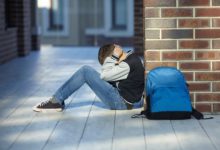As students head back to school, they’re still coping with the complicated effects of the pandemic and the transition from virtual schooling back to more structured classrooms. This has led to a spike in student misconduct, but it shouldn’t come as a surprise: Students have been expected to go back to how things were in the rush to “return to normal,” when circumstances are anything but. This approach has denied students the opportunity to process their emotions and experiences, which can explain the greater rate of “acting out” as kids navigate complicated feelings and emotions. While the U.S. Department of Education seeks to mitigate school discriminatory disciplinary action against students of color and students with disabilities as a result of the pandemic, student disciplinary practices must be critiqued and revised to avoid causing more harm as students and teachers navigate this difficult time.
One school discipline policy that is overdue for reform is the practice of removing students from the classroom when they break conduct codes. Exclusionary discipline is often an overused cop-out to real solutions. Suspension correlates with a greater likelihood of expulsions and dropping out, an outcome that hardly depicts reflection or improved behavior. COVID-19 has led to unfinished learning; students cannot afford to miss more classroom instruction. Additionally, not all students are being kicked out of the classroom at the same rate. In the 2017-18 school year, K-12 Black students received 31% of in-school suspensions, 38% of out-of-school suspensions, 39% of expulsions w/ educational services and 33% of expulsions without educational services while only comprising 15% of total student enrollment. These extreme measures are often taken for the same or lesser offenses than their White peers. As such, exclusionary discipline is inefficient and leaves room for the implicit biases of staff to affect the studies and success of underserved student populations.
I experienced school discipline reform firsthand in Massachusetts. From grades five through 12, I attended the same school which served mostly students of color — 65% Latino and 25% Black. In middle school, we morbidly joked that the school felt like a prison due to the harsh discipline system. In the classroom, students got two warnings before they got detention, but there were plenty of ways for students to unintentionally trigger detentions without any warnings at all. For example, students walked silently single file during passing periods, and any speaking was an immediate detention. Any attempt to defend yourself was an automatic escalation. For any number of misconduct reasons, groups could be assigned silent lunches or silent bus rides home. Speaking at any point during either was, of course, a detention. You could get detention for showing up late. Detention took place during lunch/recess or electives, where students would spend what would have been their social time silently copying the school’s behavioral policy by hand.
There was also a form of punishment where a student would go through their typical day, except they had to move their desk to physically separate themselves from the rest of the classroom and were not allowed to speak to their peers at any point. If they were caught conversing, the punishment would be extended another day. Discipline of this nature was very polarizing, leading students to resent strict teachers who they often received no resolution with. It also did not change student behavior, as rampant detentions felt undeserved. The harsh punishments and the lack of communication between students and disciplinarians prevented the system from helping students improve.
However, in ninth grade, the high school experienced some administrative shifts, which heralded an overhaul of the disciplinary policy. School leaders were now implementing restorative circles, an alternative where students who had received detention could choose to instead schedule a session to talk about the incident of misconduct with the dean and the teacher who gave them the referral. Immediate detentions were referred to the dean, who would read the teacher’s reason and talk to you before deciding on the consequence. These reforms created an outlet for students to address when they felt mistreated — emphasizing student voice, student agency, and repairing relationships over arbitrary adult control. Students’ relationships with high school teachers became more meaningful, and students who received consequences were less likely to receive them again in the future.
Being allowed to discuss incidents helped students to see the teacher’s perspective and vice versa, making this system much more effective than the middle school system I had previously experienced. The new system was not perfect though: Kids were still being sent out of the classroom and missing out on learning time, and the lack of a punishment to buffer the escalation from detention to suspension resulted in more frequent use of in-school suspensions.
Bolstered by the data that lays plain the shortcomings of current school discipline policies, school leaders should seek to develop more positive alternatives that keep students in the classroom, allow students to process their emotions, and provide all students with equitable treatment. The effects the discipline policies have on school climate, academic engagement, and behavioral improvement give school leaders fodder when looking to create better disciplinary codes in their schools and finding new ways to provide space for students to speak up for themselves without taking that space from classroom instruction.
Gabriel Clark is an Ed Trust summer 2022 government affairs intern.




